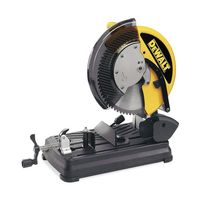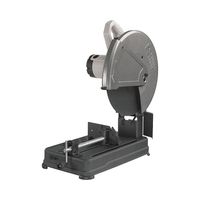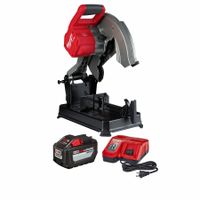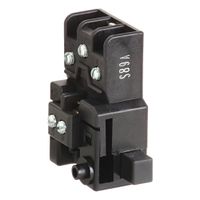Call +(254) 703 030 000 / 751 483 999 / 721 704 777
- Home
- Tools
- Power Tools
- Power Saws Blades
- Chop Saws Cut Off Machines Cold Saws
.....Read More
Frequently Asked Questions
What is the difference between a chop saw, cut-off machine, and cold saw?
A chop saw, cut-off machine, and cold saw are all tools used for cutting materials, but they differ in their design, operation, and applications.
A chop saw is a basic, portable power tool primarily used for cutting metal and other hard materials. It features an abrasive disc that spins at high speeds to cut through the material. Chop saws are typically used for rough cuts and are favored for their speed and simplicity. They are often used in construction and metalworking for cutting pipes, bars, and other metal stock.
A cut-off machine is similar to a chop saw but is generally more robust and designed for heavier-duty applications. It can be either portable or stationary and is used for cutting metal, concrete, and masonry. Cut-off machines use abrasive wheels and are often employed in construction and demolition for cutting rebar, metal pipes, and concrete. They are known for their durability and ability to handle tough materials.
A cold saw, on the other hand, uses a circular saw blade made of high-speed steel or carbide-tipped teeth. Unlike chop saws and cut-off machines, cold saws operate at lower speeds and use a coolant to keep the blade and material cool during cutting. This results in precise, clean cuts with minimal heat generation, reducing the risk of material distortion. Cold saws are typically used in metal fabrication and manufacturing for cutting steel, aluminum, and other metals with high precision.
In summary, chop saws and cut-off machines are used for fast, rough cuts in construction and demolition, while cold saws are used for precise, clean cuts in metal fabrication.
Which type of saw is best for cutting metal in high-volume applications?
A band saw is best for cutting metal in high-volume applications. Band saws are highly efficient and versatile, capable of making precise cuts in various metal types and thicknesses. They use a continuous loop of toothed metal, which allows for consistent and smooth cutting action. This makes them ideal for repetitive tasks and high-volume production environments.
Band saws come in different configurations, such as horizontal and vertical, each suited for specific tasks. Horizontal band saws are typically used for cutting larger metal pieces and are often equipped with automatic feeding systems, which enhance productivity and reduce manual labor. Vertical band saws, on the other hand, are more suitable for intricate cuts and smaller workpieces.
The blades used in band saws can be easily changed to accommodate different metals and cutting requirements, such as speed and precision. This adaptability is crucial in high-volume settings where different types of metals may need to be processed quickly.
Additionally, band saws are known for their durability and low maintenance needs, which are essential for minimizing downtime in high-volume operations. They also produce less waste compared to other saw types, as the thin blade results in a narrower kerf, conserving material and reducing costs.
Overall, the combination of speed, precision, versatility, and efficiency makes band saws the preferred choice for cutting metal in high-volume applications.
How do I choose the right blade for my chop saw or cut-off machine?
To choose the right blade for your chop saw or cut-off machine, consider the following factors:
1. **Material Type**: Identify the material you will be cutting. Use abrasive blades for metal, carbide-tipped blades for wood, and diamond blades for masonry or concrete.
2. **Blade Size**: Ensure the blade diameter matches your machine's specifications. Common sizes are 10-inch and 12-inch for chop saws.
3. **Arbor Size**: Check the arbor size of your machine and ensure the blade's arbor hole matches. Common sizes are 5/8-inch and 1-inch.
4. **Tooth Count**: For wood, a higher tooth count (60-100) provides a smoother finish, while a lower tooth count (24-40) is suitable for faster, rougher cuts. For metal, fewer teeth are better for thicker materials.
5. **Blade Material**: Choose the blade material based on durability and cutting needs. High-speed steel (HSS) is economical for general use, while carbide-tipped blades offer longevity and precision.
6. **Kerf Width**: A thinner kerf reduces material waste and requires less power, but may be less durable. Choose based on the precision and power of your machine.
7. **RPM Rating**: Ensure the blade's maximum RPM rating is compatible with your machine's speed to prevent damage or accidents.
8. **Special Features**: Consider blades with anti-vibration slots, heat expansion slots, or coatings for specific applications or improved performance.
9. **Brand and Quality**: Opt for reputable brands known for quality and reliability to ensure safety and performance.
10. **Budget**: Balance cost with quality. Investing in a higher-quality blade can save money in the long run through durability and better performance.
By considering these factors, you can select the most appropriate blade for your specific cutting needs.
What safety precautions should I take when using a chop saw or cut-off machine?
1. **Personal Protective Equipment (PPE):** Wear safety goggles or a face shield to protect your eyes from flying debris. Use hearing protection to guard against noise. Wear gloves to protect your hands, and ensure you have sturdy, non-slip footwear.
2. **Work Area:** Keep the work area clean and free of clutter. Ensure adequate lighting and ventilation. Remove any flammable materials from the vicinity.
3. **Machine Inspection:** Before use, inspect the chop saw for any damage or wear. Check the blade for sharpness and integrity. Ensure all guards are in place and functioning properly.
4. **Secure the Material:** Use clamps or a vise to secure the material being cut. This prevents movement and reduces the risk of kickback.
5. **Proper Positioning:** Stand to the side of the blade, not directly behind it, to avoid injury from kickback. Maintain a balanced stance.
6. **Blade Selection:** Use the correct blade for the material being cut. Ensure the blade is appropriate for the machine's speed and capacity.
7. **Operation:** Allow the saw to reach full speed before making contact with the material. Apply steady, even pressure without forcing the blade through the material.
8. **After Use:** Turn off the machine and wait for the blade to come to a complete stop before removing any cut pieces. Unplug the machine when changing blades or performing maintenance.
9. **Training:** Ensure you are trained in the proper use of the chop saw. Understand the machine's operation manual and follow all manufacturer guidelines.
10. **Emergency Preparedness:** Know the location of emergency shut-off switches and fire extinguishers. Have a first aid kit readily available.
How do I maintain and extend the life of my cold saw blade?
1. **Proper Installation**: Ensure the blade is correctly installed, with the right tension and alignment to prevent wobbling and uneven cuts.
2. **Correct Speed and Feed Rate**: Use the appropriate speed and feed rate for the material being cut. Refer to the manufacturer's guidelines to avoid excessive wear.
3. **Lubrication and Cooling**: Apply adequate lubrication and cooling to reduce friction and heat, which can cause blade warping and dulling.
4. **Regular Cleaning**: Clean the blade after each use to remove debris, resin, and pitch build-up that can affect performance and cause corrosion.
5. **Sharpening**: Regularly sharpen the blade to maintain its cutting efficiency. Dull blades require more force and generate more heat, leading to faster wear.
6. **Material Compatibility**: Use the blade only for its intended materials. Cutting inappropriate materials can damage the teeth and reduce lifespan.
7. **Storage**: Store the blade in a dry, clean environment to prevent rust and physical damage. Use blade protectors or cases if available.
8. **Inspection**: Regularly inspect the blade for signs of damage, such as cracks, missing teeth, or warping, and replace if necessary.
9. **Avoid Overheating**: Do not force the blade through the material. Allow it to cut at its own pace to prevent overheating and stress.
10. **Balanced Use**: Rotate between multiple blades if possible to ensure even wear and extend the life of each blade.
11. **Professional Maintenance**: Periodically have the blade professionally serviced to ensure it remains in optimal condition.
Can chop saws and cut-off machines be used to cut plastic materials?
Yes, chop saws and cut-off machines can be used to cut plastic materials, but there are important considerations to ensure safety and effectiveness.
1. **Blade Selection**: Use a blade specifically designed for cutting plastic. Blades with fine teeth or those made from carbide-tipped materials are ideal as they reduce the risk of chipping or melting the plastic.
2. **Speed and Feed Rate**: Adjust the speed and feed rate to prevent overheating, which can cause the plastic to melt. Slower speeds and steady feed rates are generally recommended.
3. **Material Support**: Secure the plastic material properly to prevent movement during cutting. Use clamps or a vice to hold the material in place.
4. **Cooling**: Consider using a cooling method, such as air or water, to dissipate heat generated during the cutting process. This helps in maintaining the integrity of the plastic.
5. **Safety Precautions**: Wear appropriate personal protective equipment (PPE) such as safety goggles and gloves. Ensure the work area is well-ventilated to avoid inhaling any fumes that may be released.
6. **Type of Plastic**: Different plastics have varying properties. Softer plastics like PVC or acrylic are generally easier to cut, while harder plastics may require more specialized blades or techniques.
7. **Test Cuts**: Perform test cuts on scrap pieces to fine-tune the settings and ensure the desired quality of the cut.
By following these guidelines, chop saws and cut-off machines can effectively and safely cut plastic materials.
What are the advantages of using a cold saw over other types of saws for metal cutting?
1. **Precision and Accuracy**: Cold saws provide high precision and accuracy in cutting, resulting in clean, burr-free edges. This reduces the need for secondary finishing processes.
2. **Cool Cutting Process**: The cutting process generates minimal heat, preventing material distortion and preserving the mechanical properties of the metal.
3. **Long Blade Life**: The use of high-speed steel or carbide-tipped blades ensures durability and a longer lifespan compared to abrasive saws, reducing the frequency of blade replacements.
4. **Consistent Performance**: Cold saws maintain consistent cutting performance over time, providing uniform cuts and reducing material wastage.
5. **Versatility**: They can cut a wide range of metals, including ferrous and non-ferrous materials, and are suitable for various shapes and sizes, from tubes to solid bars.
6. **Reduced Noise and Vibration**: The operation of cold saws is quieter and produces less vibration compared to abrasive saws, enhancing the working environment and reducing operator fatigue.
7. **Safety**: The design and operation of cold saws typically include safety features that protect operators from accidents, such as blade guards and automatic shut-off mechanisms.
8. **Efficiency**: Cold saws offer faster cutting speeds and higher productivity, making them ideal for high-volume production environments.
9. **Minimal Material Loss**: The thin kerf of cold saw blades results in less material loss, optimizing material usage and reducing costs.
10. **Ease of Use**: Many cold saws come with user-friendly controls and features, making them easy to operate even for less experienced users.
11. **Environmental Benefits**: The reduced heat and noise generation contribute to a more environmentally friendly operation compared to other metal cutting methods.





